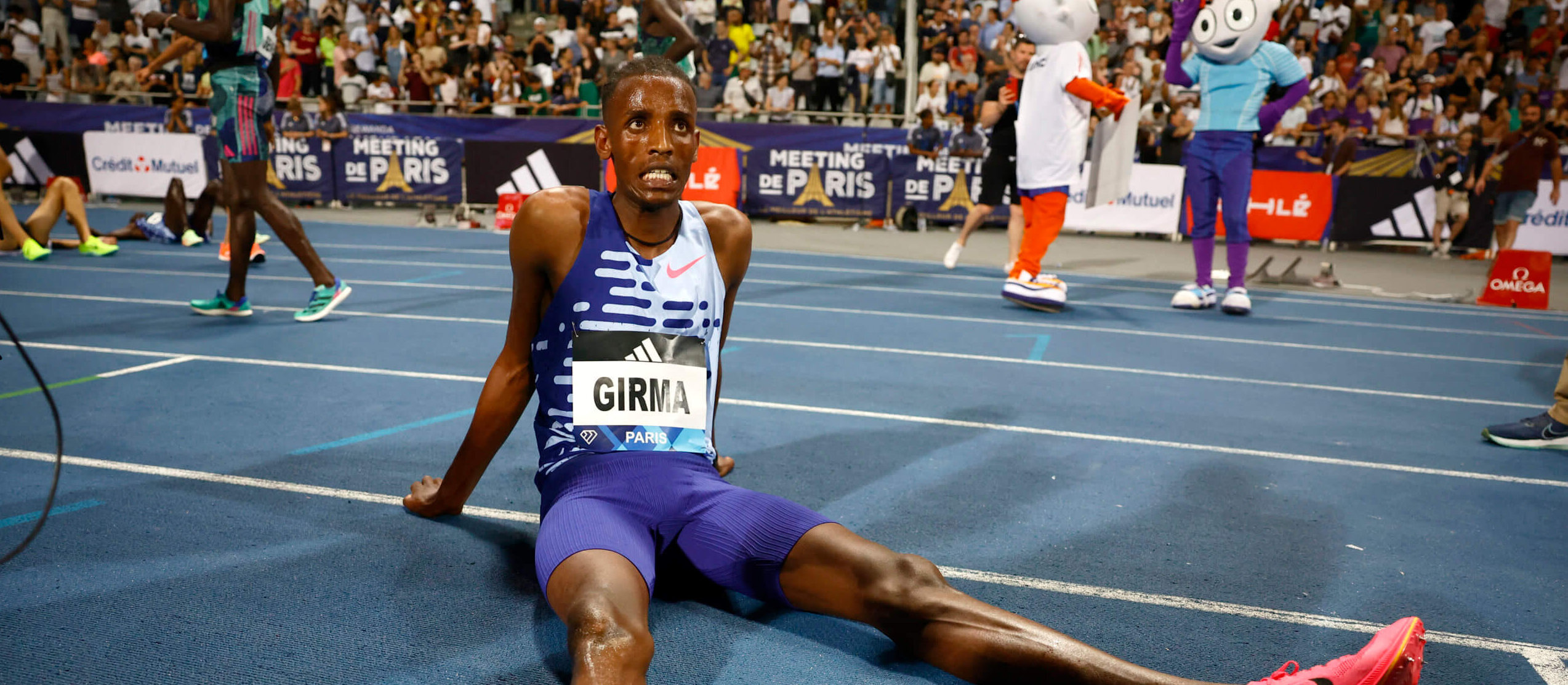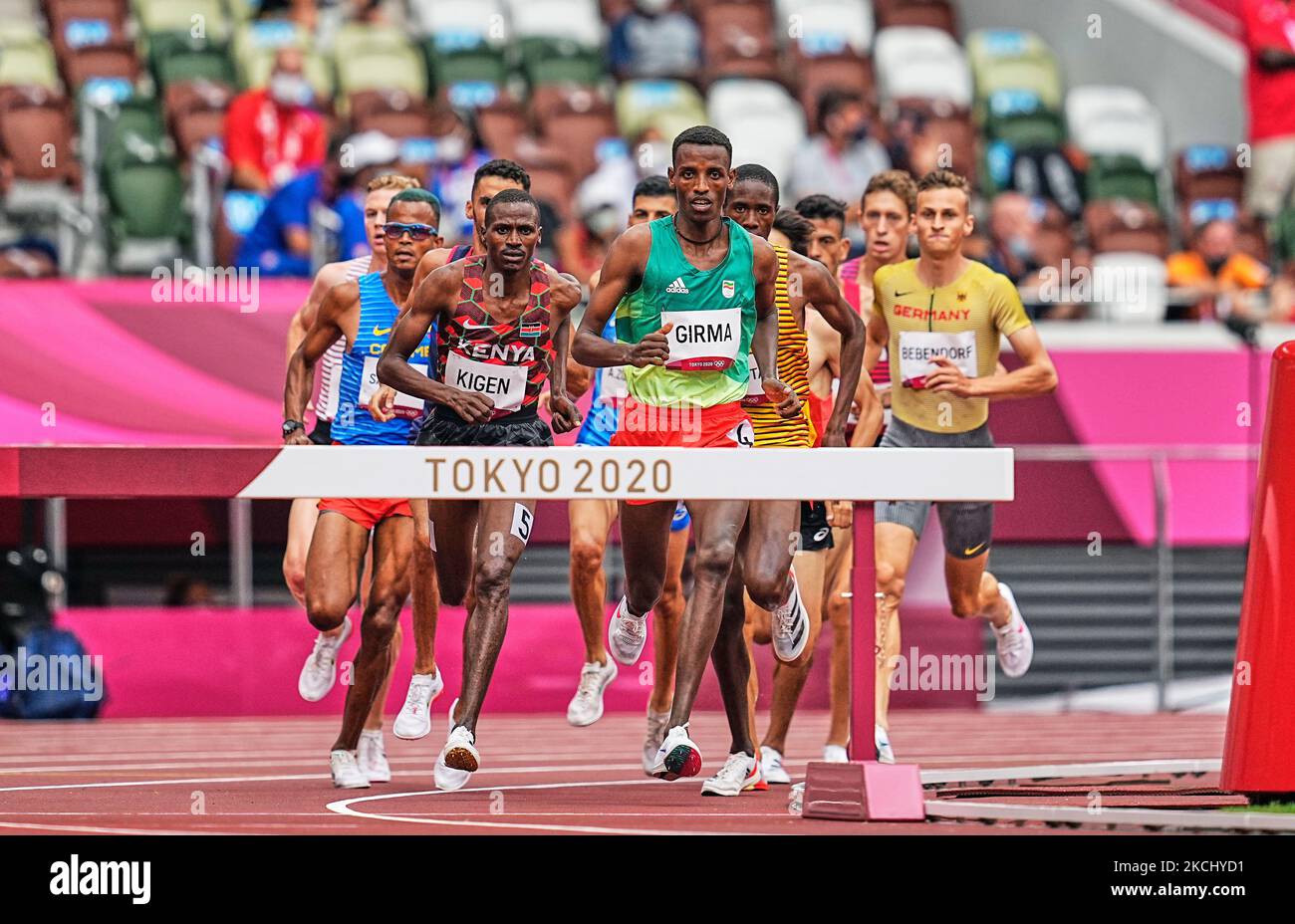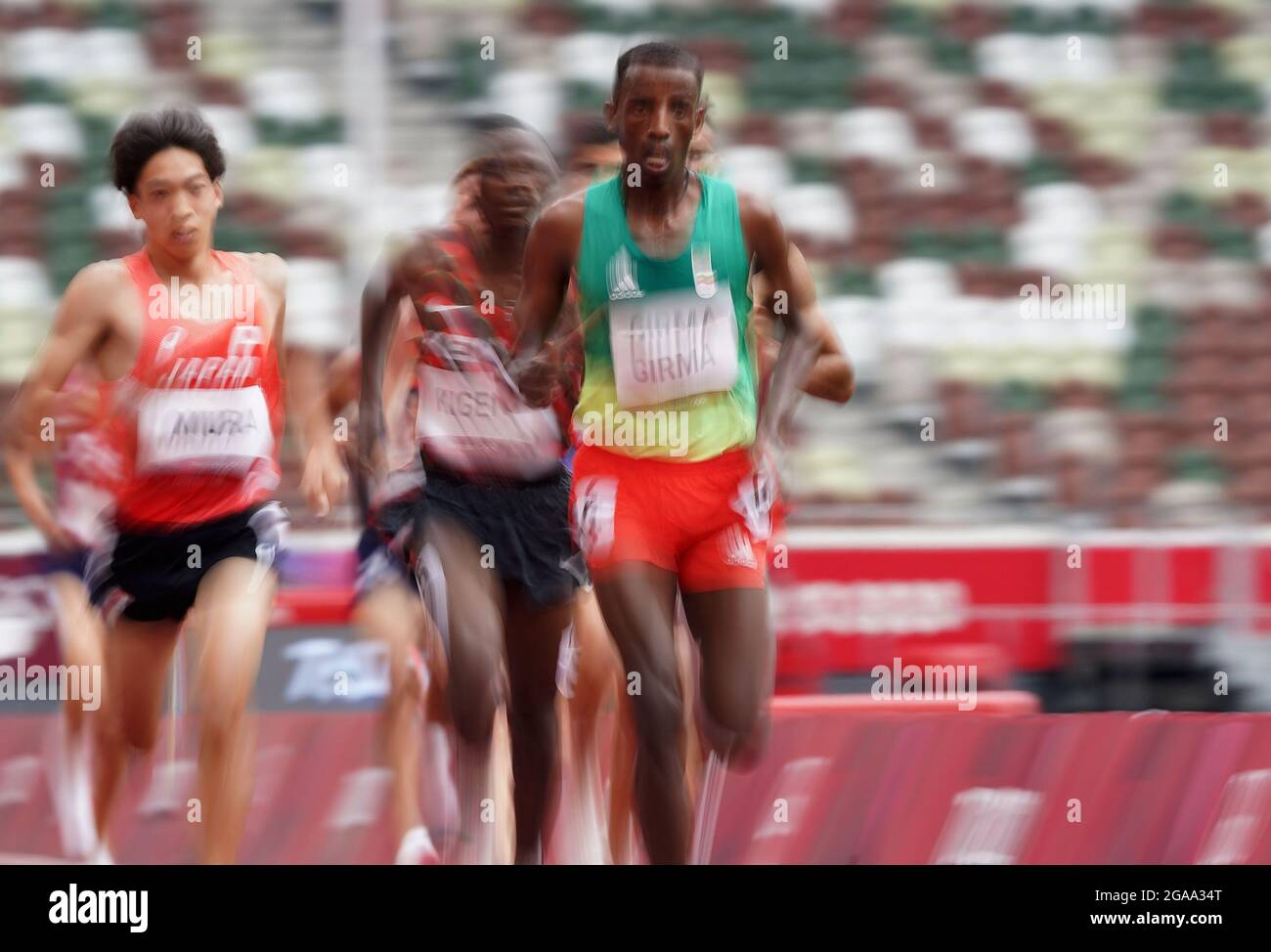The Girma Steeplechase Fall

The Girma Steeplechase Fall, a harrowing incident that occurred during the 2012 Olympic Games in London, remains etched in the annals of athletics history. It serves as a stark reminder of the inherent dangers associated with this demanding discipline.
Historical Significance, Girma steeplechase fall
The fall, involving Ethiopian steeplechase runner, Girma Mecheso, took place during the men’s 3000m steeplechase final. It transpired as Girma, a promising athlete with a personal best time of 8:04.63, was vying for a medal. As he approached the final water jump, a miscalculation resulted in a dramatic and unfortunate fall, leaving him injured and unable to continue the race. The incident shocked spectators and fellow athletes alike, highlighting the precarious nature of steeplechase, where a single misstep can have significant consequences.
Impact on Steeplechase
The Girma Steeplechase Fall had a profound impact on the sport of steeplechase. It triggered discussions and debates about safety measures, particularly regarding the water jump. This incident prompted the International Association of Athletics Federations (IAAF) to review the design and construction of water jumps, aiming to enhance athlete safety.
Stories of Prominent Athletes
The fall also prompted numerous athletes to share their own experiences with the water jump, highlighting the inherent risks and challenges it presents. Several athletes, including the legendary Kenyan steeplechaser, Ezekiel Kemboi, acknowledged the difficulty of negotiating the water jump, emphasizing the importance of maintaining focus and executing the jump flawlessly.
Analyzing the Fall

The Girma Steeplechase Fall, a harrowing incident that shook the equestrian world, demands a thorough analysis to understand its contributing factors and consequences. Examining the incident through a multi-faceted lens, considering safety protocols, historical comparisons, and immediate and long-term implications, provides valuable insights for future prevention and mitigation strategies.
Potential Causes of the Fall
The Girma Steeplechase Fall, a tragic event, was likely influenced by a complex interplay of factors. While a definitive cause might be difficult to pinpoint, several potential contributing factors merit investigation.
- Horse’s Condition: The horse’s physical and mental state could have played a crucial role. Pre-existing injuries, fatigue, or a lack of training could have contributed to the fall.
- Course Conditions: The condition of the course, including the terrain, obstacles, and weather, could have presented unforeseen challenges. Poorly maintained fences or slippery ground could have increased the risk of a fall.
- Rider’s Experience: The rider’s experience and skill level could have influenced the outcome. A lack of experience in steeplechase racing or inadequate training could have contributed to the fall.
- Equipment Failure: Malfunctioning equipment, such as saddles, bridles, or stirrups, could have compromised the rider’s control and safety.
Safety Protocols in Place
Safety protocols are paramount in steeplechase racing to minimize the risk of accidents. The Girma Steeplechase, adhering to established safety standards, implemented various measures to ensure the well-being of both horses and riders.
- Course Inspection: Rigorous pre-race inspections of the course, including fences, terrain, and obstacles, were conducted to identify and rectify any potential hazards.
- Veterinary Checks: Horses underwent thorough veterinary checks to assess their fitness and suitability for racing. These checks included examinations of their health, soundness, and racing history.
- Rider Equipment: Riders were required to wear appropriate safety gear, including helmets, protective vests, and boots, to minimize the risk of injuries in case of a fall.
- Emergency Response: A dedicated emergency response team, including veterinarians, paramedics, and rescue personnel, was on standby to provide immediate medical assistance in case of an accident.
Comparison to Similar Incidents
The Girma Steeplechase Fall echoes similar incidents in steeplechase history, highlighting the inherent risks associated with this demanding equestrian discipline.
- The Grand National Fall (2018): This incident, involving a horse named ‘Up For Review’, resulted in a catastrophic fall and multiple injuries to the horse and jockey. The fall was attributed to a combination of factors, including the horse’s inexperience and a challenging obstacle.
- The Cheltenham Gold Cup Fall (2017): During this prestigious race, a horse named ‘Don Poli’ suffered a severe fall, leading to the rider’s hospitalization. The fall was linked to the horse’s unfamiliarity with the course and a sudden change in direction.
Consequences of the Fall
The Girma Steeplechase Fall had both immediate and long-term consequences, impacting the lives of the horse, rider, and the sport itself.
- Immediate Consequences: The fall resulted in serious injuries to both the horse and rider. The horse sustained a fractured leg, requiring immediate veterinary attention and possible euthanasia. The rider suffered a concussion and multiple fractures, necessitating extensive medical treatment.
- Long-Term Consequences: The fall had a significant impact on the horse’s career, potentially ending it prematurely. The rider’s recovery was prolonged, impacting their ability to compete for an extended period. The incident also raised concerns about the safety of steeplechase racing, prompting calls for stricter safety protocols and a review of the sport’s regulations.
Lessons Learned and Future Implications: Girma Steeplechase Fall

The Girma Steeplechase Fall, a pivotal moment in the sport’s history, has triggered a wave of introspection and a renewed focus on safety. The incident served as a stark reminder of the inherent risks associated with steeplechase, prompting the sport’s governing bodies and stakeholders to take immediate and long-term measures to mitigate future risks.
Safety Improvements
Following the fall, the steeplechase community, driven by a shared commitment to athlete safety, implemented several key safety improvements. These changes aim to address the specific factors that contributed to the incident and create a safer environment for all participants.
| Safety Improvement | Description |
|---|---|
| Water Jump Redesign | The water jump design has been revised, incorporating a shallower water depth and a wider landing area, reducing the risk of serious injury upon landing. |
| Barrier Height Adjustments | The height of the barriers has been adjusted to ensure a more gradual transition for athletes, reducing the potential for abrupt changes in momentum and minimizing the risk of falls. |
| Improved Course Maintenance | The course is now subject to more rigorous and frequent maintenance, ensuring a consistent and safe surface for athletes. This includes regular checks of the barriers, water jumps, and surrounding areas. |
| Increased Medical Personnel | The number of medical personnel on site during steeplechase events has been increased, ensuring immediate and efficient response to any injuries. This includes a dedicated team of medical professionals trained in emergency care. |
Recommendations for Preventing Similar Incidents
In addition to the immediate safety improvements, the steeplechase community has developed a comprehensive set of recommendations to prevent similar incidents from occurring in the future. These recommendations address both technical and procedural aspects of the sport, aiming to create a safer environment for athletes.
- Enhanced Athlete Training: Implementing specialized training programs that focus on water jump technique and barrier clearance, equipping athletes with the necessary skills to navigate these challenging obstacles safely.
- Improved Risk Assessment: Conducting thorough risk assessments of the course before each event, identifying potential hazards and implementing appropriate mitigation strategies. This includes evaluating the water jump, barriers, and overall course conditions.
- Enhanced Communication and Coordination: Fostering open communication between athletes, coaches, and officials, ensuring everyone is aware of the risks and safety protocols. This includes clear communication regarding course conditions and potential hazards.
- Technological Advancements: Exploring the use of technology to enhance safety, such as wearable sensors to monitor athlete performance and identify potential risks, and advanced video analysis to assess course conditions and identify potential hazards.
Role of Technology in Enhancing Steeplechase Safety
Technology plays a crucial role in enhancing steeplechase safety by providing real-time data and insights that can be used to mitigate risks and improve athlete performance.
- Wearable Sensors: These sensors can monitor athlete heart rate, oxygen levels, and other vital signs, providing valuable data that can be used to identify potential health risks and ensure athlete well-being. This technology can also be used to track athlete performance and identify areas for improvement.
- Video Analysis: Advanced video analysis tools can be used to assess course conditions and identify potential hazards, allowing officials to make informed decisions about course safety. This technology can also be used to analyze athlete performance and identify areas for improvement in technique and strategy.
- Artificial Intelligence: AI algorithms can be used to analyze data from wearable sensors and video analysis, providing insights that can be used to improve athlete safety and performance. This technology can also be used to predict potential risks and develop targeted safety interventions.
Impact on the Sport’s Future
The Girma Steeplechase Fall has had a profound impact on the future of the sport, leading to a renewed focus on safety and a commitment to creating a safer environment for athletes. This incident has prompted a paradigm shift in the way the sport is managed, with a greater emphasis on risk mitigation, athlete well-being, and technological advancements.
- Increased Awareness: The incident has raised public awareness about the risks associated with steeplechase, prompting a wider discussion about athlete safety and the need for comprehensive safety measures.
- Enhanced Regulations: The incident has led to the implementation of stricter regulations and guidelines for steeplechase events, ensuring a safer environment for all participants. These regulations address course design, safety protocols, and athlete training standards.
- Technological Innovation: The incident has spurred innovation in the use of technology to enhance steeplechase safety. This includes the development of wearable sensors, advanced video analysis tools, and AI algorithms designed to mitigate risks and improve athlete performance.
Girma steeplechase fall – Girma’s tumble in the steeplechase was a real shocker, mate. It’s a tough event, you know, especially when you’re up against the Ethiopians. They’re renowned for their dominance in the ethiopia steeplechase , with their lightning-fast pace and effortless hurdle clearance.
Poor Girma, though, he just couldn’t handle the pressure and went down like a sack of potatoes.
Remember that gnarly steeplechase fall Girma took? Turns out it wasn’t just a bit of a wobble, he’s actually got a bit of a nasty injury. Check out this lamecha girma injury update for the lowdown. Hopefully, he’ll be back on his feet soon, because the track scene just isn’t the same without him.